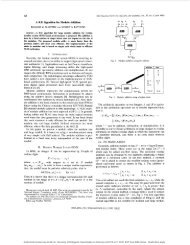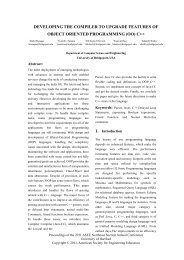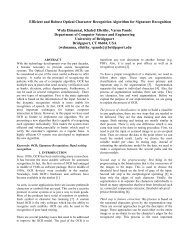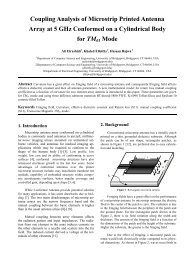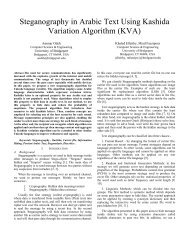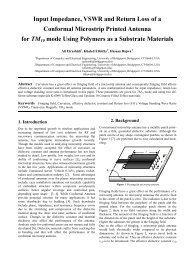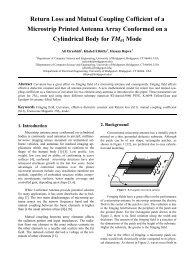Optimized Algorithm for Fire Detection over WSN ... - ResearchGate
Optimized Algorithm for Fire Detection over WSN ... - ResearchGate
Optimized Algorithm for Fire Detection over WSN ... - ResearchGate
Create successful ePaper yourself
Turn your PDF publications into a flip-book with our unique Google optimized e-Paper software.
According to the acoustic ranging principle, the counter<br />
of master node has to be reset as soon as the node receives<br />
the RF packet. To allocate the fire place we have to<br />
calculate the time of flight of the sound signal by the<br />
sounder. It is calculated based on the time that took of the<br />
master node’s microphone to receive the sound signal.<br />
This approach is one of the easiest and non-expensive<br />
ways to allocate the fire without having a prior knowledge<br />
of the location of the node or acknowledgement from the<br />
detected node about the fire’s location.<br />
3.3 Methodology<br />
In our experimental tests we use MICA2 motes. The<br />
model we use is MPR400CB and the data radio is<br />
CC1000900mhz. Hence, the MTS300 CA is used in order<br />
to extent the sound, temperature and light sensors. The<br />
proposed frame work involves programming the motes<br />
<strong>for</strong> permitting them to communicate with the master node<br />
and allow the master node to communicate with base<br />
station. The sensors send the readable data to the base<br />
station. The data describes the increase in the temperature<br />
of the fire as shown in our implementation in Figure 4.<br />
Based on our study we found that there is a relation<br />
between the fire’s temperature and their colors. It is<br />
shown below whenever the temperature increases the<br />
color changes in several gradients. That can help us in<br />
detecting the size of the fire based on its colors.<br />
1. Red: as the temperature increases, the redness changes<br />
until it reach the cherry color be<strong>for</strong>e it changes to next<br />
case.<br />
a. Observable: 980 °F (525 °C).<br />
b. Bright: 1,300 °F (700 °C).<br />
c. Cherry, bright: 1,500 °F (800 °C).<br />
d. Cherry, full: 1,700 °F (900 °C).<br />
e. Cherry, pure: 1,800 °F (1,000 °C).<br />
2. Orange:<br />
a. Deep: 2,000 °F (1,100 °C).<br />
b. Pure: 2,200 °F (1,200 °C).<br />
3. White<br />
a. Whitish: 2,400 °F (1,300 °C).<br />
b. Cheerful: 2,600 °F (1,400 °C).<br />
c. Impressive: 2,700 °F (1,500 °C).<br />
In section 4 we discuss the results of our implementation<br />
and how with higher temperature and lower resistance of<br />
CKT we can get correct data.<br />
Figure 4:measured data of temperature of the fire is giving by several<br />
detected sensors<br />
4. ANALYSIS THE RESULTS<br />
As shown in section 3, we have used the MTS300CA<br />
sensor. MTS300CA helps in monitoring the energy of the<br />
fire and detects it as it moves around. The more fire<br />
spread around, the more nodes become active to detect the<br />
fire.<br />
A. The relation between the measured temperature and<br />
the accuracy data scenario:<br />
The complete <strong>Fire</strong> <strong>Detection</strong> system is implemented in<br />
NES C in UNIX Tiny OS plat<strong>for</strong>m or its equivalent<br />
Cygwin on a windows plat<strong>for</strong>m. A standard MEMSIC<br />
sensor board the MTS 300 mounted on top of the MICAZ<br />
was used <strong>for</strong> communication. An MIB 510 Program board<br />
isused to program the individual motes. The experimental<br />
results are conducted on a Pentium 2.4GHz computer<br />
system.<br />
Figure 5 shows the relation between the resistances in the<br />
board to the temperature. By examining Figure 5, we can<br />
conclude that the temperature increases as the resistance<br />
decreases which lead to the accuracy of the measurements<br />
in temperature. The Cdse Photon sensors of the MTS 300<br />
boards works as the primary detector in the initial<br />
detection of fire because factors like extreme sunlight or<br />
artificial light can confuse the photo sensor the thermistor<br />
of MTS300 takes care of the secondary measurement of<br />
temperature. Although the motes work perfectly<br />
individually, in order to c<strong>over</strong> a large area it is required to<br />
have multiple motes communicating with each other. As<br />
the distribution of motes is random we use the acoustic<br />
ranging technique which allows the motes to define its<br />
location to the base station.



